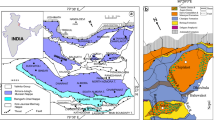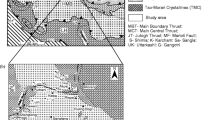Abstract
Late Archaean to Palaeoproterozoic felsic magmatic lithounits exposed in the central part of the Bundelkhand massif have been mapped and their redox series (magnetite vs ilmenite series) evaluated based on magnetic susceptibility (MS) data. The central part of Bundelkhand massif comprises of multiple felsic magmatic pulses (∼2600–2200 Ma), commonly represented by coarse grained granite (CGG-grey granite, CPG-pink granite), medium grained pink granite (MPG), fine grained pink granite (FPG), grey and pink rhyolites and granite porphyry (GP). However, the pink colour of these felsic rocks is the result of hydrothermal fluid-flushing leading to potassic alteration of grey granites. MS values of CGG vary from 0.058 to 14.75×10−3 SI with an average of 6.35×10−3 SI, which mostly represent oxidized type, magnetite series (73%) granites involving infracrustal (igneous) source materials. CPG (av. MS=3.95×10−3 SI) is indeed a pink variety of CGG, the original oxidizing nature of which must have been similar to the bulk of CGG, but has been moderately to strongly reduced because of distinctly more porphyritic nature together with partial assimilation of metapelitic (supracrustal) materials, surmicaceous enclaves, carbonaceous material included in the source materials, and to some extent, induced by hydrothermal and later deformational processes. MPG (av. MS= 1.15×10−3 SI) as lensoidal stock-like bodies intrudes the CPG and represent both magnetite series (18%) and ilmenite series (82%) granites, which are probably formed by heterogeneous (mixed) source rocks. GP (av. MS=6.26×10−3 SI) occur as dykes (mostly trending NE-SW) intrudes the MPG, CPG and migmatites and bears the nature similar to oxidized type, magnetite series granite. FPG (av. MS= 0.666×10−3 SI) trending NE-SW occur as lensoid bodies including a large outcrop, is intrusive into both CPG and MPG, and is moderately to very strongly reduced type, ilmenite series granites, which may be derived by the melting of metapelitic crustal sources. FPG hosting microgranular (mafic magmatic) enclaves commonly exhibit high MS values (7.31–10.22×10−3 SI), which appear induced by the mixing and mingling of interacting felsic and mafic magmas prevailed in an open system. Grey (av. MS=10.30×10−3 SI) and pink (av. MS=6.72×10−3 SI) rhyolites represent oxidized type, magnetite series granites, which may have been derived from infracrustal (magmatic) protoliths. Granite series evaluation of felsic magmatic rocks of central part of Bundelkhand massif strongly suggests their varied redox conditions (differential oxygen fugacity) mostly intrinsic to magma source regions and partially modified by hydrothermal and tectonic processes acting upon them.
Similar content being viewed by others
References
Basu, A.K. (1986) Geology of parts of the Bundelkhand granite massif, central India. Rec. Geol. Surv. India, v.117,Pt.2, pp.61–124.
Basu, A.K. (2007) Role of Bundelkhand granite massif and Son-Narmada megafault in Precambrian crustal evolution and tectonism in central and western India. Jour. Geol. Soc. India, v.70, pp.745–770.
Castro, A., Moreno-Ventas, I. and Dela Rosa, J.D. (1991) Htype (hybrid) granitoids: a proposed revision of the granitetype classification and nomenclature. Earth Sci. Rev., v.31, pp.237–253.
Chappell, B.W. and White, A.J.R. (1974) Two contrasting granite types. Pacific Geol., v.8, pp.173–174.
Dall’Agnol, R. and Oliveira, D.C. (2007) Oxidized, magnetiteseries, rapakivi-type granites of Carajás, Brazil: implications for classification and petrogenesis of A-type granites. Lithos, v.93, pp.215–233.
Ghosh, D. and Acharya, G.K. (2006) Structural features of Bundelkhand granite complex delineated by aeromagnetic expression around Jhansi, Uttar Pradesh. Jour. Geol. Soc. India, v.68, pp.1008–1022.
Gregorová, D., Hrouda, F. and Kohút, M. (2003) Magnetic susceptibility and geochemistry of Variscan West Carpathian granites: implications for tectonic setting. Phys. Chem. Earth, v.28, pp.729–734.
Hart, C.J.R., Goldfarb, R.J., Lewis, L.L. and Mair, J.L. (2004) The northern Cordilleran Mid-Cretaceous plutonic province: ilmenite/magnetite-series granitoids and intrusion related mineralization. Resou. Geol., v.54, pp.253–280.
Ishihara, S. (1977) The magnetite-series and ilmenite-series granitic rocks. Minn. Geol., v.27, pp.293–305.
Ishihara, S. (1990) The Inner Zone Batholith vs the Outer Zone Batholith of Japan: evaluation from their magnetic susceptibility. Univ. Mus., Univ. Tokyo. Nature and Culture, No.2, pp.21–24.
Kanaya, H. and Ishihara, S. (1973) Regional variation of magnetic susceptibility of the granitic rocks in Japan. Jour. Japan. Assoc. Mineral. Petrol. Econ. Geol., v.68, pp.219–224.
Kumar Santosh and Rino, V. (2007) Redox series evaluation of Cu(±Mo±Au) hosting Palaeoproterozoic Malanjkhand granitoids and enclaves, central India: Evidence from magnetic susceptibility, phase petrology and geochemistry. Jour. Econ. Geol. Geores. Manag., v.4, pp.105–127.
Kumar Santosh and Singh, Kh. M. (2008) Granite series evaluation of Early Ordovician Kyrdem granitoids and enclaves, Meghalaya plateau, northeast India: implication on oxidation condition of interacting mafic-felsic magma system. Earth Sci. India., v.1(IV), pp.204–219. (http://www.eartscienceindia.info)
Kumar Santosh and Pathak, M. (2009) Magnetic susceptibility and geochemistry of felsic igneous rocks from western Arunachal Himalaya: implication on granite series evaluation in orogenic belt. In: Santosh Kumar (Ed.), Magmatism, Tectonism and Mineralization, Macmillan Publishers India Ltd., New Delhi, India, pp.74–91.
Kumar Santosh, Pieru, T. and Rino, V. (2005) Evaluation of granitoid-series and magmatic oxidation of Neoproterozoic South Khasi Granitoids and their microgranular enclaves, Meghalaya: constraints from magnetic susceptibility and biotite composition. Jour. App. Geochem., v.7, pp.175–194.
Kumar Santosh, Singh, B., Joshi, C.C. and Pandey, A. (2006) Magnetic susceptibility and biotite composition of granitoids of Amritpur region, Kumaun Lesser Himalaya: Implication on granite series evaluation and nature of felsic magma. Jour. Geol. Soc. India, v.68, pp. 666–674.
Mondal, M.E.A., Goswami, J.N. Deomurari, M.P. and Sharma, K.K. (2002) Ion microprobe 207Pb/206Pb ages of zircons from the Bundelkhand massif, northern India: Implication for crustal evolution of the Bundelkhand-Aravalli protocontinent. Precambrian Res., v.117, pp.85–100.
Pati, J. K., Patel, S. C., Pruseth, K. L., Malviya, V. P., Arima, M., Raju, S., Pati, P. and Prakash, K. (2007) Geology and geochemistry of giant quartz veins from the Bundelkhand craton, central India and their implications. Jour. Earth Syst. Sci., v. 116, pp. 497–510.
Pitcher, W.S. (1983) Granite: typology, geological environment and melting relationships. In: M.P. Atherton and C.D. Gribble, (Eds.), Migmatites, Melting and Metamorphism, Shiva Pub. Ltd., Cheshire, U. K., pp.277–285.
Raju, S. (2004) Petrology and petrogenesis of basic dykes swarms of Bundelkhand granitoid complex in parts of Lalitpur and Mahoba districts, southern Uttar Pradesh. Unpublished Ph.D thesis, University of Lucknow.
Ramakrishnan, M. and Vaidyanadhan, R. (2008) Geology of India. Geol. Soc. India, Bangalore, v.1, 556p.
Sharma, R., Murthy, Ch. V.V.S., Gouda, H.C. and Singh R.K. (2006) Analysis of aeromagnetic data over part of Bundelkhand granite complex for geology and structure. Jour. Geol. Soc. India, v.68, pp.949–958.
Singh, B. and Kumar Santosh (2005) Petrogenetic appraisal of Early Palaeozoic granitoids of Kinnaur district, Higher Himachal Himalaya, India. Gondwana Res., v.8, pp.67–76.
Subrahmanayam, A.V., Sinha, K.K. and Bagchi, A.K. (2004) A note on petrography and chemistry of microgranular enclaves and granitoids around Talbahat, Lalitpur district, Uttar Pradesh. Jour. Geol. Soc. India, v.65, pp.92–96.
Takagi, T. (2004) Origin of magnetite and ilmenite-series granitic rocks in the Japan Arc. Amer. Jour. Sci., v.304, pp.169–202.
Takagi, T. and Tsukimura, K. (1997) Genesis of oxidized- and reduced-type granites. Econ. Geol., v. 92, pp. 81–86.
Takahasi, M., Aramaki, S. and Ishihara, S. (1980) Magnetiteseries/ilmenite-series vs I-type/S-type granitoids. Minn. Geol. Spec. Issue, v.8, pp.13–28.
Whalen, J.B., Currie, K.L. and Chappell, B.W. (1987) Atype granites: geochemical characteristics, discrimination and petrogenesis. Contrib. Mineral. Petrol., v. 95, pp. 407–419.
Author information
Authors and Affiliations
Corresponding author
Rights and permissions
About this article
Cite this article
Kumar, S., Raju, S., Pathak, M. et al. Magnetic susceptibility mapping of felsic magmatic lithounits in the central part of Bundelkhand Massif, central India. J Geol Soc India 75, 539–548 (2010). https://doi.org/10.1007/s12594-010-0046-4
Received:
Accepted:
Published:
Issue Date:
DOI: https://doi.org/10.1007/s12594-010-0046-4




